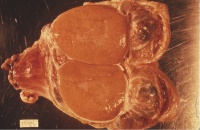Also Known As: Ram Epididymitis – Orchitis – Ovine Contagious Epididymitis – Brucella ovis Epididymitis.
Caused By: Brucella ovis and Brucella melitensis
Introduction
Ovine brucellosis causes reproductive disease in sheep, mainly in rams.
B. ovis is the least virulent of all the Brucella species.
The disease is on List B of the Office des International des Epizooties [www.oie.int/ (OIE)] It is therefore notifiable to the OIE.
Signalment
The disease is unique to sheep.
Distribution
Present in all countries where sheep are intensively farmed. It is transmitted mainly through semen but shedding is unreliable.
Ewes can also act as indirect vectors for brucellosis if they mate with both an infected and uninfected ram during the same oestrus cycle.
Abortion materials and vaginal discharge also contain Brucella organisms
Brucellosis is not considered zoonotic.
Clinical Signs
Epididymitis in rams with swelling and enlargement of testes, scrotum, penis and prepuce. Decreased reproductive performance will be noticed due to impaired spermatogenesis.
Testicular atrophy occurs in chronic infections.
Occasionally also abortion in ewes and weak lambs. This only occurs due to placental necrosis in ewes exposed in the first two trimesters of pregnancy.
Diagnosis
Palpation of the testes is suggestive but not definitive.
Specific immunofluorescent staining of semen smears is confirmatory.
Brucella organisms can also be isolated from the epididymis and accessory sex glands at necropsy, although excretion is intermittent so false negatives are not uncommon.
ELISA and Complement Fixation are also commonly used for serological diagnosis.
Treatment
Antibiotic therapy is very expensive, prolonged and ineffective.
Control
Testing and culling of breeding stock is essential to ensure carriers are not present within a flock.
No vaccine is available for B. ovis and vaccination against B. melitensis can interfere with serological diagnosis.
References
Animal Health & Production Compendium, Brucellosis (B ovis) datasheet, accessed 06/06/2011 @ http://www.cabi.org/ahpc/
| This article has been peer reviewed but is awaiting expert review. If you would like to help with this, please see more information about expert reviewing. |
